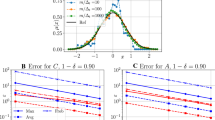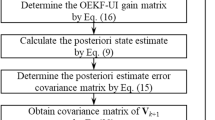Abstract
In the paper, we consider the problem of robust approximation of transfer Koopman and Perron–Frobenius (P–F) operators from noisy time-series data. In most applications, the time-series data obtained from simulation or experiment are corrupted with either measurement or process noise or both. The existing results show the applicability of algorithms developed for the finite-dimensional approximation of the deterministic system to a random uncertain case. However, these results hold only in asymptotic and under the assumption of infinite data set. In practice, the data set is finite, and hence it is important to develop algorithms that explicitly account for the presence of uncertainty in data set. We propose a robust optimization-based framework for the robust approximation of the transfer operators, where the uncertainty in data set is treated as deterministic norm bounded uncertainty. The robust optimization leads to a min–max type optimization problem for the approximation of transfer operators. This robust optimization problem is shown to be equivalent to regularized least-square problem. This equivalence between robust optimization problem and regularized least-square problem allows us to comment on various interesting properties of the obtained solution using robust optimization. In particular, the robust optimization formulation captures inherent trade-offs between the quality of approximation and complexity of approximation. These trade-offs are necessary to balance for the proposed application of transfer operators, for the design of optimal predictor. Simulation results demonstrate that our proposed robust approximation algorithm performs better than some of the existing algorithms like extended dynamic mode decomposition (EDMD), subspace DMD, noise-corrected DMD, and total DMD for systems with process and measurement noise.























Similar content being viewed by others
Notes
With some abuse of notation, we are using the same notation for the P–F operator defined on the space of measure and densities.
References
Abu-Mostafa, Y.S., Magdon-Ismail, M., Lin, H.-T.: Learning from Data, vol. 4. AMLBook, New York (2012)
Bagheri, S.: Effects of weak noise on oscillating flows: linking quality factor, floquet modes, and Koopman spectrum. Phys. Fluids 26(9), 094104 (2014)
Budisic, M., Mohr, R., Mezic, I.: Applied koopmanism. Chaos 22(4), 047510–33 (2012)
Caramanis, C., Mannor, S., Xu, H.: Robust optimization in machine learning. In: Sra, S., Nowozin, S., Wright, S.J. (eds.) Optimization for Machine Learning. MIT Press, Cambridge (2012)
Crnjaric-Zic, N., Macesic, S., Mezic, I.: Koopman operator spectrum for random dynamical system. arXiv preprint arXiv:1711.03146 (2017)
Dawson, S.T., Hemati, M.S., Williams, M.O., Rowley, C.W.: Characterizing and correcting for the effect of sensor noise in the dynamic mode decomposition. Exp. Fluids 57(3), 42 (2016)
Dellnitz, M., Junge, O.: On the approximation of complicated dynamical behavior. SIAM J. Numer. Anal. 36, 491–515 (1999)
Dellnitz, M., Junge, O.: Set oriented numerical methods for dynamical systems. Handb. Dyn. Syst. 2, 221–264 (2002)
Dellnitz, M., Junge, O., Koon, W.S., Lekien, F., Lo, M., Marsden, J.E., Padberg, K., Preis, R., Ross, S.D., Thiere, B.: Transport in dynamical astronomy and multibody problems. Int. J. Bifurc. Chaos 15, 699–727 (2005)
El Ghaoui, L., Lebret, H.: Robust solutions to least-squares problems with uncertain data. SIAM J. Matrix Anal. Appl. 18(4), 1035–1064 (1997)
Froyland, G.: Extracting dynamical behaviour via Markov models. In: Mees, A. (ed.) Nonlinear Dynamics and Statistics: Proceedings, Newton Institute, Cambridge, 1998, pp. 283–324. Birkhauser (2001)
Hemati, M.S., Rowley, C.W., Deem, E.A., Cattafesta, L.N.: De-biasing the dynamic mode decomposition for applied Koopman spectral analysis of noisy datasets. Theor. Comput. Fluid Dyn. 31(4), 349–368 (2017)
Huang, B., Vaidya, U.: Data-driven approximation of transfer operators: naturally structured dynamic mode decomposition. arXiv:1709.06203 (2016)
Junge, O., Osinga, H.: A set oriented approach to global optimal control. ESAIM Control Optim. Calc. Var. 10(2), 259–270 (2004)
Junge, O., Marsden, J.E., Mezic, I.: Uncertainty in the dynamics of conservative maps. In: 43rd IEEE Conference on Decision and Control, 2004, vol. 2, pp. 2225–2230. CDC. IEEE (2004)
Korda, M., Mezić, I.: Linear predictors for nonlinear dynamical systems: Koopman operator meets model predictive control. arXiv preprint arXiv:1611.03537 (2016)
Kutluay, S., Bahadir, A., Ozde, A.: Numerical solution of one-dimensional burgers equation: explicit and exact-explicit finite difference methods. J. Comput. Appl. Math. 103(2), 251–261 (1999)
Mauroy, A., Mezic, I.: A spectral operator-theoretic framework for global stability. In: Proceedings of IEEE Conference of Decision and Control, Florence, Italy (2013)
Mehta, P.G., Vaidya, U.: On stochastic analysis approaches for comparing dynamical systems. In: Proceeding of IEEE Conference on Decision and Control, Spain, pp. 8082–8087 (2005)
Mezić, I.: Spectral properties of dynamical systems, model reduction and decompositions. Nonlinear Dyn. 41(1–3), 309–325 (2005)
Mezic, I., Banaszuk, A.: Comparison of systems with complex behavior: spectral methods. In: Proceedings of the 39th IEEE Conference on Decision and Control (Cat. No.00CH37187), vol. 2, pp. 1224–1231 (2000)
Mezić, I., Banaszuk, A.: Comparison of systems with complex behavior. Phys. D 197, 101–133 (2004)
Raghunathan, A., Vaidya, U.: Optimal stabilization using lyapunov measures. IEEE Trans. Autom. Control 59(5), 1316–1321 (2014)
Rowley, C.W., Mezić, I., Bagheri, S., Schlatter, P., Henningson, D.S.: Spectral analysis of nonlinear flows. J. Fluid Mech. 641, 115–127 (2009)
Schmid, P.J.: Dynamic mode decomposition of numerical and experimental data. J. Fluid Mech. 656, 5–28 (2010)
Surana, A., Banaszuk, A.: Linear observer synthesis for nonlinear systems using Koopman operator framework. In: Proceedings of IFAC Symposium on Nonlinear Control Systems, Monterey, California (2016)
Susuki, Y., Mezic, I.: Nonlinear Koopman modes and coherency identification of coupled swing dynamics. IEEE Trans. Power Syst. 26(4), 1894–1904 (2011)
Takeishi, N., Kawahara, Y., Yairi, T.: Subspace dynamic mode decomposition for stochastic Koopman analysis. Phys. Rev. E 96, 033310 (2017). https://doi.org/10.1103/PhysRevE.96.033310
Vaidya, U., Mehta, P.G.: Lyapunov measure for almost everywhere stability. IEEE Trans. Autom. Control 53(1), 307–323 (2008)
Williams, M.O., Kevrekidis, I.G., Rowley, C.W.: A data-driven approximation of the Koopman operator: extending dynamic mode decomposition. J. Nonlinear Sci. 25(6), 1307–1346 (2015)
Author information
Authors and Affiliations
Corresponding author
Additional information
Communicated by Dr. Alain Goriely.
Publisher's Note
Springer Nature remains neutral with regard to jurisdictional claims in published maps and institutional affiliations.
Financial support from the Department of Energy DOE Grant DE-OE0000876 is gratefully acknowledged.
Appendix
Appendix
1.1 A. Proof of Theorem 6
Proof
The min–max optimization problem is
Fix \(\mathbf{K}\in \mathbb {R}^{L\times L}\) and let
be the worst-case residual. Then,
Now, for a \(L\times L\) matrix \(M=[m_{i,j}]\in \mathbb {R}^{L\times L}\), let \(\hbox {vec}(M)\) denote the vector
This follows from the fact that \(\mathbb {R}^{L\times L}:= \mathbb {R}^L\otimes \mathbb {R}^L \cong \mathbb {R}^{L^2}\). Hence, \(\parallel M\parallel _F = \parallel \hbox {vec}(M)\parallel _2\).
Let
and
Then,
Hence, from (40) and (42), the worst-case residual (24) is
\(\square \)
Rights and permissions
About this article
Cite this article
Sinha, S., Huang, B. & Vaidya, U. On Robust Computation of Koopman Operator and Prediction in Random Dynamical Systems. J Nonlinear Sci 30, 2057–2090 (2020). https://doi.org/10.1007/s00332-019-09597-6
Received:
Accepted:
Published:
Issue Date:
DOI: https://doi.org/10.1007/s00332-019-09597-6
Keywords
- Data driven analysis
- Koopman operator
- Robust Koopman operator
- Operator theoretic methods
- Dynamical systems




